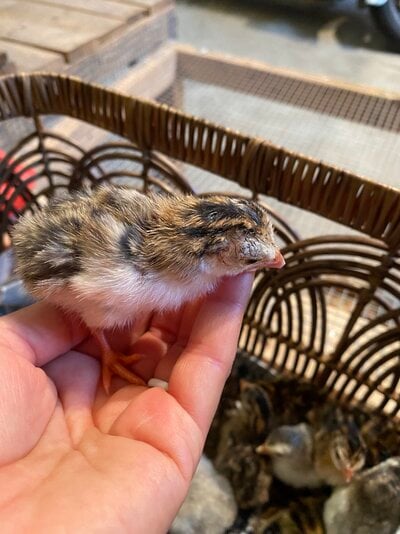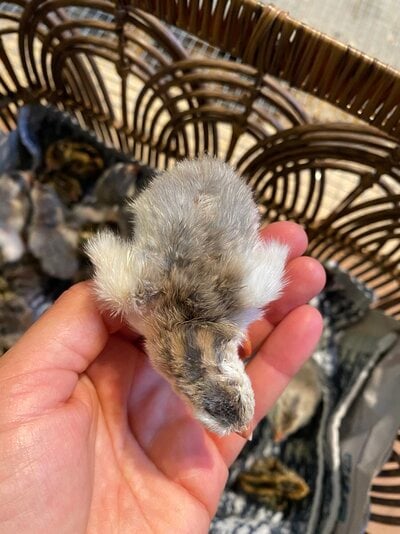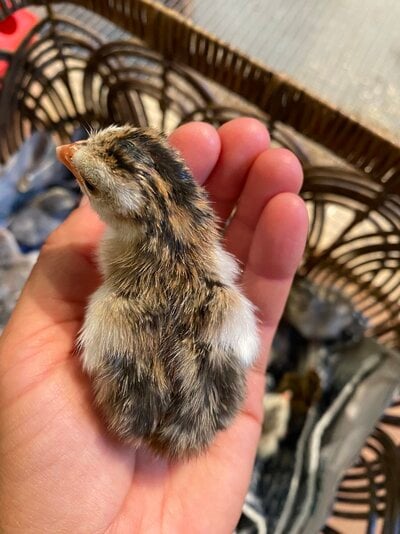She is talking about a Violet not a Royal Purple.Cute babies! I wish I could join the hatchalong but my guineas are pretty unhappy about being locked up due to HPAI and so aren’t laying well right now. As for your Lavender x Royal Purple cross, it depends on what recessive genes are present, as is also the case for your Pearl greys. I’ve been following the terminology and test breedings from Dana Manchester’s Facebook groups and I think they would say that the lavender is homozygous for blue and either het or homozygous for fully dotted or pearled. The RP would be homozygous or heterozygous for Grey and homozygous for semi-dotted. So, if there were no recessive genes hiding, then the keets would be heterozygous for one Grey and one Blue, which would give a Grey phenotype. For the dotting, you would also be heterozygous for semipearled, which would give a fully pearled phenotype. So then your keets would present as wild type (Pearl Grey) but be split to lavender and semipearled. However, any recessive genes would change that calculation.
Navigation
Install the app
How to install the app on iOS
Follow along with the video below to see how to install our site as a web app on your home screen.
Note: This feature may not be available in some browsers.
More options
You are using an out of date browser. It may not display this or other websites correctly.
You should upgrade or use an alternative browser.
You should upgrade or use an alternative browser.
Guinea Hatch-along!
- Thread starter m1chelle1
- Start date
I see I misread that! Same though as attenuates crossed with non-attenuates should produce Pearl Grey unless their are recessives hiding in the lavender. I obtained a few attentuates (violet and slate) and have been hatching from them for the last two years. Their mate is a pied Pearl grey cock. They’ve produced Pearl grey, royal purple, and pied of both over the past two years with not one violet or slate keet. I’m hoping that the addition of more attenuates this past year means that I’ll finally get some attenuate keets, but I don’t even know who they’ve paired with and my eggs aren’t well fertilized right now. I’m just eating their eggs until they can free range again.She is talking about a Violet not a Royal Purple.
It is possible that some Royal Purples and some Violets do have the dominant gray color gene. The gray gene has been proven to be a dominant color gene which causes the color to be expressed even if there is just one gray color gene.I see I misread that! Same though as attenuates crossed with non-attenuates should produce Pearl Grey unless their are recessives hiding in the lavender. I obtained a few attentuates (violet and slate) and have been hatching from them for the last two years. Their mate is a pied Pearl grey cock. They’ve produced Pearl grey, royal purple, and pied of both over the past two years with not one violet or slate keet. I’m hoping that the addition of more attenuates this past year means that I’ll finally get some attenuate keets, but I don’t even know who they’ve paired with and my eggs aren’t well fertilized right now. I’m just eating their eggs until they can free range again.
I have not seen any proof that the gray color gene can be hidden by recessive color genes. You are breeding yours to Pearl Grays that do have the gray color gene. The fact that you are getting offspring that are not all Pearl Gray proves that you cock is heterozygous for the gray color gene and some unknown color gene.
I regularly produce Royal Purple keets by mating a Chocolate cock with a Coral Blue hen. Neither of these birds have a gray color gene. Their offspring are either Chocolate, Royal Purple or possibly Bronze. Based on the color genes the parents have, these Chocolates and Royal Purples should have one blue color gene and one of whatever genes a chocolate has. The claim is that chocolates have the buff gene and 2 DSV genes.
If this was a one time happening I would have no problem believing it was a random mutation but this happens every time their eggs are hatched.
For my attenuates, the violet hen would be a semipearled attenuate and the slate hen a semipearled attenuate. The cock is fully pearled grey pied. RP is two semipearled genes with a grey base color. So I think the RP keets indicate that the cock has one semipearled gene that’s recessive to his pearled gene. Either hen could be contributing the other semipearled gene:since Violet would have two semipearled genes and Slate could also have a recessive semipearled gene.It is possible that some Royal Purples and some Violets do have the dominant gray color gene. The gray gene has been proven to be a dominant color gene which causes the color to be expressed even if there is just one gray color gene.
I have not seen any proof that the gray color gene can be hidden by recessive color genes. You are breeding yours to Pearl Grays that do have the gray color gene. The fact that you are getting offspring that are not all Pearl Gray proves that you cock is heterozygous for the gray color gene and some unknown color gene.
I regularly produce Royal Purple keets by mating a Chocolate cock with a Coral Blue hen. Neither of these birds have a gray color gene. Their offspring are either Chocolate, Royal Purple or possibly Bronze. Based on the color genes the parents have, these Chocolates and Royal Purples should have one blue color gene and one of whatever genes a chocolate has. The claim is that chocolates have the buff gene and 2 DSV genes.
If this was a one time happening I would have no problem believing it was a random mutation but this happens every time their eggs are hatched.
If you follow their genetic charts, then chocolate would be semipearled with dark dunne modifying the grey, all homozygous. The coral blue would be semipearled lavender, all homozygous. So offspring would have the underlying grey color gene of the chocolate parent, be homozygous for semipearled (one from each semipearled parent), but only one gene each (heterozygous) for lavender and dark dunne. Since lavender and dark dunne are recessive to grey, you would only see the grey background color, with the semipearled effect that makes it RP. That’s my understanding of it anyway.
What are you calling "the Gray color gene?"It is possible that some Royal Purples and some Violets do have the dominant gray color gene. The gray gene has been proven to be a dominant color gene which causes the color to be expressed even if there is just one gray color gene.
I have not seen any proof that the gray color gene can be hidden by recessive color genes. You are breeding yours to Pearl Grays that do have the gray color gene. The fact that you are getting offspring that are not all Pearl Gray proves that you cock is heterozygous for the gray color gene and some unknown color gene.
I regularly produce Royal Purple keets by mating a Chocolate cock with a Coral Blue hen. Neither of these birds have a gray color gene. Their offspring are either Chocolate, Royal Purple or possibly Bronze. Based on the color genes the parents have, these Chocolates and Royal Purples should have one blue color gene and one of whatever genes a chocolate has. The claim is that chocolates have the buff gene and 2 DSV genes.
If this was a one time happening I would have no problem believing it was a random mutation but this happens every time their eggs are hatched.
Example of a variety it shows in please.
Also what genes do these Royal Purples and Violets have that don't have a gray color gene?
Violets are solid colored and do not have any semi dotting genes.Violet would have two semipearled genes
As far as I have researched, this is their speculation and has not been verified by DNA testing.If you follow their genetic charts, then chocolate would be semipearled with dark dunne modifying the grey, all homozygous. The coral blue would be semipearled lavender, all homozygous. So offspring would have the underlying grey color gene of the chocolate parent, be homozygous for semipearled (one from each semipearled parent), but only one gene each (heterozygous) for lavender and dark dunne. Since lavender and dark dunne are recessive to grey, you would only see the grey background color, with the semipearled effect that makes it RP. That’s my understanding of it anyway.
Chocolates are semi dotted but may or may not be homozygous for that condition. Female chocolates only have one of whatever gene causes the chocolate color since it is sex linked.
Breeding results have proven that my Royal Purple hen is heterozygous for the semi dotting gene with the other being the no dotting gene.
Due to the unique known parentage of my guineas and breeding results my Lavender hen is homozygous for the blue color gene and heterozygous for the full dotting gene and the no dotting gene.
My original Coral Blues are all proven to be homozygous for the blue color gene and heterozygous for the partial dotting gene and the no dotting gene.
The dominant gray gene that Pearl Grays have.What are you calling "the Gray color gene?"
- Thread starter
- #18
Any color guesses on them?
Attachments
Congratulations on all the pretty babies!View attachment 3126388More babies! Quite a few from my violet x lavender pair! Picture number 2 & 4 are two of their babies, which all look the same so far. I had 2 different people say that pair would produce Pearl gray, and they haven’t produced any so far. I’ve hatched about 7 eggs from the pair so far and all the babies look exactly the e same
Any color guesses on them?
 It looks like you had a good hatch! For your zoomed in pics, do you have a lavender and two pied Pearl grays? I’m not seeing the head well enough to tell for sure if they are royal purple vs pied Pearl grey, but I think I see a center stripe, which would be Pearl gray… Are any of the parents white or pied?
It looks like you had a good hatch! For your zoomed in pics, do you have a lavender and two pied Pearl grays? I’m not seeing the head well enough to tell for sure if they are royal purple vs pied Pearl grey, but I think I see a center stripe, which would be Pearl gray… Are any of the parents white or pied?- Thread starter
- #20
For the ones you said are pied Pearl gray or royal purple, the parents are my lavender x violet pairCongratulations on all the pretty babies!It looks like you had a good hatch! For your zoomed in pics, do you have a lavender and two pied Pearl grays? I’m not seeing the head well enough to tell for sure if they are royal purple vs pied Pearl grey, but I think I see a center stripe, which would be Pearl gray… Are any of the parents white or pied?
Similar threads
New posts New threads Active threads
-
Latest threads
-
Portable tractor question in predator heavy environment
- Started by Rachelz
- Replies: 0
-
-
-
-
-
-
Threads with more replies in the last 15 days
-
Checking-In On Peeps - Post Here To Say Hello!
- Started by Nifty-Chicken
- Replies: 2K
-
-
-
-
Can I get some help from someone with careless neighbours who own dogs.
- Started by RiDaGeckoGuy
- Replies: 103
-






